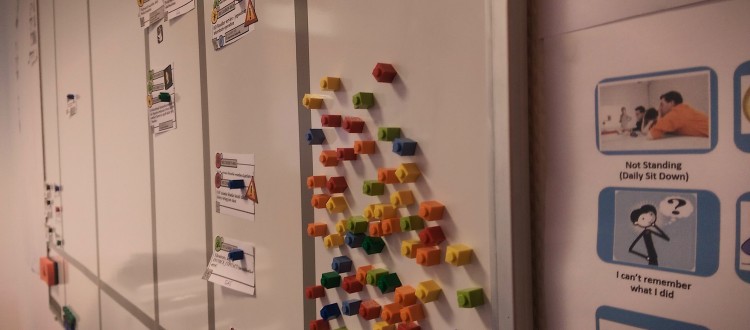Why promote analog kanban boards in the 21st century?
In our world, tons of agile online solutions could be picked up. I mean, most of them are really good. However most of the agile newbie teams want to use them as a comfortable ticketing system, and start to think about analog kanban board as an absolutely unnecessary thing. What is the problem with this behaviour?
Peter Kerschbaumer wrote about this:
“One problem of all the fancy software development systems is that people can hide behind them. Product owners write their user stories and once they are in production developers write their comments in them and wait and wait and wait… for somebody to answer their questions. In my world one of the corner stones of getting work done is team work, simple collaboration between developers and product owners. Nothing is better than a normal white board for that. Sure there is some extra effort needed to keep the analog board up to date, but the advantage of having it for daily standups is significant.Analog Kanban Board – mirror of Target Process used for team discussions.”
My experience as an agile coach is the same. I have found the best and fastest way to collaborate as a team and get an overview the current development situation is using a physical kanban board.
Let’s get an overview of physical kanban board advantages based on a post by Cheryl Hammond
PROS OF PHYSICAL BOARDS
- Flexible, easy to make incremental process change
- Can display definitions of done per column and elsewhere
- Can display system-level WIP (aggregate across all columns)
- Can support blocked flags in any column/state
- Can support sub-states
- Can support split/parallel states
- Can easily indicate multiple team members working on one backlog item
- Can easily limit a team member’s WIP (e.g., to 1) by limiting number of avatars per person
- Tells a story from a distance/in aggregate
- Unavoidable; information is always available without the team having to intentionally open it
- Visible (and unavoidable) beyond the immediate team
- Go viral, generating enthusiasm and buy-in throughout the organization
- Fun; team can own the board and play with it (fun avatars and other art, beer column, etc.)
- Can easily hold the daily standup at the board (if collocated)
- Team members appreciate the physicality of moving a sticky across the board
- Moving stickies focuses the team on the right things in the daily standup
At this point we should highlight a very important thing: the lean roots. When a team uses a ticketing system with its limitations, that means limitations for waste visualisation, too. Every kanban, scrum, scrumban and lean team must focus on wastes because they want to improve their processes by eliminating waste continuously. That is essential lean basic, and all the agile methods based on lean. However, on retrospective meetings teams talk about impediments and improvement actions, but generally most of the lean waste types are not visualized, and not improved.
Analog kanban boards could help us to visualize, measure and eliminate the lean waste types easy as pie.
by Bence Kulcsar
